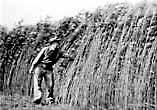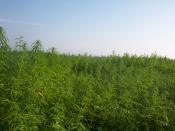Hemp came to America on the Mayflower-woven into the ship's sails and rigging. It covered Conestoga wagons trudging west. According to legend, Betsy Ross stitched it into that famous flag, and Levi Strauss sewed it into the first pair of gold miner's jeans. Hemp was a cash crop for rope, twine, canvas and cellulose in the United States until 1937, when it was outlawed by the federal government, largely because major chemical companies-competing for the war industry with synthetic fibers-lobbied for the Marijuana Tax Act.
Now is the time for the comeback of the world most versatile and oldest cultivated fiber plant in the world. Hemp can be used for body care (such as cosmetics, shampoo, etc.), foods and beverages, building materials, fuel (Biodiesel and a new ethanol), paper, and textiles (from clothing to linens). Hemp is stronger than cotton and Hemp grows well without herbicides, fungicides, or pesticides. Almost half of the agricultural chemicals used on US crops are applied to cotton.
Hemp is also more resilient to UV rays. Hemp produces more pulp per acre than timber on a sustainable basis, and can be used for every type of paper. Hemp paper manufacturing can reduce wastewater contamination. Hemp's low need for acids used in pulping, and its creamy color lends itself to environmentally friendly bleaching instead of harsh chlorine compounds and less bleaching results in fewer chemical byproducts. As for food, Hemp Seed is far more nutritious than even soybean, contains more essential fatty acids than any other source, is second only to soybeans in complete protein (but is more digestible by humans), is high in B-vitamins, and is 35% dietary fiber. Yes, hemp does contains trace amounts of THC, the active substance in marijuana, but hemp's THC quantities are so tiny that it's literally impossible to get...



Interesting fact
There is a shop in britain, The Body Shop, which sell a range of hemp toiletries ( and very nice they are too), when they first came out there was a big fuss, before the owner pointed out that you`d have to smoke a joint the size of a TELEGRAPH POLE to get high from hemp. What is the goverment trying to pull by calling it a drug when you can get cigarettes and alchol over the counter?
4 out of 4 people found this comment useful.